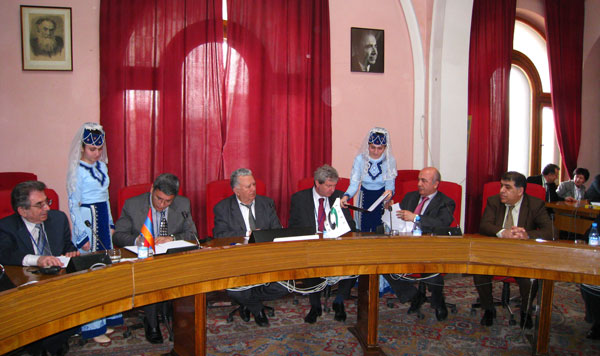ISTC and Armenian Government Agree on Co-Funding of Science Projects

01 April 2009 - The International Science and Technology Center (ISTC) and the State Committee of Science of the Ministry of Education and Science of the Republic of Armenia signed a Memorandum of Understanding (MOU) on co-funding of science projects. The Armenian State Committee of Science agreed to finance selected projects in a range of 10-20%.
Since 1995, when the first Armenian project was launched, ISTC has funded 155 science projects to a total value of 36.7 million USD. ISTC has also invested in other activities in the Republic, such as commercialization projects and capacity building programs available to scientists from all research institutes.
a
ISTC Executive Director, Adriaan van der Meer, said after signing the MOU: “This is an important step towards a deeper collaboration with the Armenian scientific community. There is great potential here and we will keep working closely with scientists and institutes to develop it further”.
During his visit to Armenia, Mr. van der Meer met with Prof. Samvel Harutunyan, Chairman of the State Committee of Science of RA (signature authority for the MOU), Academician Radik Martirosyan, President of National Academy of Sciences of the Republic of Armenia (RA), Nerses Yeritzyan, Minister of Economy of RA, Academician Yuri Shoukourian, Vice-President of the National Academy of Sciences RA, and many Directors of institutes and managers of ISTC projects. They discussed how ISTC could further contribute to scientific and economic advancement by bringing the results of research to the marketplace.
Mr van der Meer also attended the seminar “Commercialization of Scientific Investigations” held in Yerevan on April 1-3 and visited the Institute of Biotechnology and the Institute for Informatics and Automation Problems where several ISTC projects are being carried out.

Welcome Address
Adriaan van der Meer
Executive Director
International Science and Technology Centre, Moscow
at the Seminar
Commercialization of Scientific Investigations
In the National Academy of Sciences
of the Republic of Armenia
Yerevan - Tsahkadzor
April 1-3, 2009
Dear Mr. Chairman,
Welcome
It gives me great pleasure to say a couple of words at the opening of today’s conference. Personally I am delighted to be back in your country. My first visit to Armenia was already more than 10 years ago.I am sure that my present visit will add to my first good impressions. I have already noticed positive changes in the city.
At the beginning of this introduction, I would like to express special gratitude to:
- Academician Radik Matirosyan, President of the National Academy of Sciences,
- H.E. Nerses Yeritzyan, Minister of Economy,
- Professor Samvel Harutunyan, Chairman of the State Committee of Sciences,
- Academician Yuri Shoukourian, Vice-President of the National Academy of Sciences,
- Directors of institutes,
- managers of ISTC projects and,
- last but not least - the Head and staff of the ISTC Branch office for all their work.
I thank you all very much for being present today and I would like to thank all those who organized this conference. I will be visiting some institutes during my stay here and I look forward to signing the Memorandum of Understanding on co-funding of ISTC projects with the State Committee of Science of the Ministry of Education and Science of the Republic of Armenia.
Today’s conference takes place at an important moment for ISTC. The Center has been in existence for fifteen years and official celebrations will take place on 10 December in Moscow.
Results
The International Science and Technology Center - ISTC - is an international research-funding agency based on an international agreement. It has funded more than 2600 projects. There are many success stories to tell. Our funded research has led to new medicines, cleaner motors and new materials for example for aircraft. New jobs have been created and know-how has been mobilized for one of the greatest experiments taking place in the world today: the Large Hadron Collider of CERN.
Our work has led to the creation of an important civilian research community and to the establishment of important international scientific networks. Thanks to the realization of ISTC projects, Armenian scientists have been able to forge important international collaboration networks, for example in the framework of the regional Armenian project on mitigation of risk of natural hazards which also involves scientists from Kyrgyzstan, Georgia, and Tajikistan.
Armenia and ISTC
Armenia joined ISTC in the year it was established and a year later, in 1995, it started to cooperate in an ISTC funded project in the field of radiation. Many other ISTC projects followed, a branch office was opened and lately a resource center was established here in Yerevan. Armenian researchers are trained in this center.
To date ISTC has financed 155 projects in Armenia. These projects cover a wide range of scientific fields from physics, chemistry and biotechnology to material science. The total volume of the funds allocated by ISTC to Armenia is 36.7 million USD. A great variety of institutes from Armenia are implementing our projects.
I am proud to say that many successes have been achieved both for the institutes and the individual researchers. Our policy of only funding projects that ensure cooperation between leading scientific centers and researchers from different countries all over the world is one of the determining factors of success. For example, through ISTC projects, real international scientific cooperation has been achieved between research institutes in Armenia and institutes in the European Union.
Mr. Chairman,
Opportunities
The work of ISTC has evolved during recent years. Today a broad range of programs and projects are available. Individual Armenian researchers take part in our work and are encouraged to continue to so. There are many opportunities available also under our partner program, such as collaboration with reputable private companies. The aim of this program is to bring private capital to the institutes. I would like to see more ISTC partner projects in Armenia.
Commercialization
Let me now turn to the issue of commercialization. In 2003 a Commercialization Support Program was established at ISTC to act as the interface between the business world and CIS innovation. The main aim of the Commercialization Support Program is to bring marketable, revenue-producing hi-tech goods and services to the market and to create sustainable jobs. ISTC takes no profits, royalties, or equities related to these projects.
The commercialization program has funded 28 Innovation Initiatives for more than $11.5M since 2003, including two Innovation Initiatives funded in Armenia in 2007. One of these initiatives is a project at the Research Institute of Biotechnology in Yerevan. In the framework of this project,ISTC has helped to createa small-scale production line for optically active non-protein α-amino acids used in medicine, pharmacology, and bacteriology. The implementation of this project will lead to the creation of 34 permanent jobs.
The other Innovation Initiative that currently is being executed in Armenia is at LT-Pyrkal, Yerevan. It will create 50 extra jobs and involves the development of a production line for the processing of large sized optical sapphire crystals by the Horizontal Directed Crystallization (HDC) method.
I am pleased that you have chosen the issue of commercialization as the subject of your conference. ISTC stands ready to finance new initiatives in this field.
Targeted initiatives
ISTC carries out a great number of projects in many different fields. However, it is important to concentrate our efforts around a number of specific themes taking the latest scientific developments into account. That is why a number of targeted initiatives have been established to focus our work and to achieve a high level of impact. These targeted initiatives relate to the development of new medicines and to specific actions to counter bio-terrorism. The aim with regard to countering bio-terrorism is to develop detection methods with respect to viruses that can cause infectious diseases. ISTC is looking for additional funding for these important initiatives. I would like to thank Armenia in particular for the interest it has shown in participating in targeted initiatives.
Final
Successful research can only be carried through international contacts and networks. ISTC as a multilateral Center is, per definition, one of the best vehicles for bringing researchers together from all over the world. The Center looks forward to close collaboration with the Armenian research community.
I expect that today’s conference will define our common future role and in particular will lead to concrete proposals for future cooperation in the field of commercialization.
I am looking forward to the three days we will spend together in Yerevan and in the beautiful town of Tsahkadzor, located in the picturesque mountainous region of Armenia.
I wish you a fruitful conference,
I thank you for your attention.

